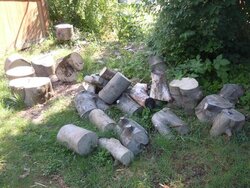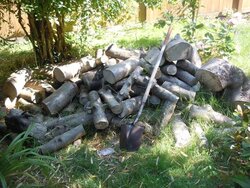S
-
Active since 1995, Hearth.com is THE place on the internet for free information and advice about wood stoves, pellet stoves and other energy saving equipment.
We strive to provide opinions, articles, discussions and history related to Hearth Products and in a more general sense, energy issues.
We promote the EFFICIENT, RESPONSIBLE, CLEAN and SAFE use of all fuels, whether renewable or fossil.
You are using an out of date browser. It may not display this or other websites correctly.
You should upgrade or use an alternative browser.
You should upgrade or use an alternative browser.
- Status
- Not open for further replies.
S
StihlHead
Guest
Buckeye 2012
Member
S
StihlHead
Guest
Wood Duck
Minister of Fire
I'd like to see bigger pictures or closer shots. It is hard to tell what the tree is from the photos. I can't think of a tree that meets your description of an eastern tree that grows commonly in the NW except maybe Black Locust, which the wood in the photos is not.
S
StihlHead
Guest
As my grandmother used to say, 'If wishes were horses, beggars would ride." Those are the only photos I have, as that wood is gone now.
I can assure you that this species is very common here. It is not indigenous to the PNW and was originally brought here in the late 19th century. The photos are very typical of the wood, and it is an extremely common species (not some rare exotic).
I can assure you that this species is very common here. It is not indigenous to the PNW and was originally brought here in the late 19th century. The photos are very typical of the wood, and it is an extremely common species (not some rare exotic).
pyroholic
Member
PA. Woodsman
Minister of Fire
Based on the "whitish" color of the wood and the little "knobs" on it where the branches sprout I am going to take a stab at it and guess some sort of Holly.....am I close?
Applesister
Minister of Fire
Too lazy to look anything up and the only smooth bark trees that I know are Red maples. Acer rubrum. If Norways can spread all over the Pacific northwest, why not Reds?
Oh heck...Red maple for $10.00
I dont see any dark heartwood there, though. It looks mapley but it doesnt...
Oh heck...Red maple for $10.00
I dont see any dark heartwood there, though. It looks mapley but it doesnt...
Woody Stover
Minister of Fire
Here, the upper branches on Red Maple may be smooth but further down it gets rougher.the only smooth bark trees that I know are Red maples.....I dont see any dark heartwood there, though. It looks mapley but it doesnt...
Uhhhh, Hackberry??
Dude, there's more grass in those pics than wood. The next step is to start a thread where viewers are required to wear blindfolds.


S
StihlHead
Guest
Based on the "whitish" color of the wood and the little "knobs" on it where the branches sprout I am going to take a stab at it and guess some sort of Holly.....am I close?
Not only close, but spot on. It is holly. English or American, I am not sure which. Holly is a weed here, and I have a lot of it always sprouting all over my property. They grow pretty large here. They are also grow commercially here for making wreaths, and the birds spread the seeds around like crazy. They are not well known for firewood, but they are above average in heat and the wood burns well. The wood is also used for white inlay, like boxwood.
Here is your prize money (in keeping with current events):

S
StihlHead
Guest
Dude, there's more grass in those pics than wood. The next step is to start a thread where viewers are required to wear blindfolds.
Well, as you all just want to complain about these threads, I will just stop posting them.
The intent was to inform and educate, but y'all just want more and better photos and some kind of simplistic puzzle to solve on a silver platter.
So I will not bother. Happy now, dude?
PA. Woodsman
Minister of Fire
Not only close, but spot on. It is holly. English or American, I am not sure which. Holly is a weed here, and I have a lot of it always sprouting all over my property. They grow pretty large here. They are also grow commercially here for making wreaths, and the birds spread the seeds around like crazy. They are not well known for firewood, but they are above average in heat and the wood burns well. The wood is also used for white inlay, like boxwood.
Here is your prize money (in keeping with current events):
View attachment 105208
I had a feeling it was Holly by the things I mentioned. I see it here in PA. once and awhile and it does burn very nice.
Thanks for the prize money-drinks and eats are on the Woodsman!


Wood Duck
Minister of Fire
pyroholic
Member
Well, as you all just want to complain about these threads, I will just stop posting them.
The intent was to inform and educate, but y'all just want more and better photos and some kind of simplistic puzzle to solve on a silver platter.
So I will not bother. Happy now, dude?
Don't stop yet, I think I'm close to getting one... Maybe. Heck, I thought I had that one. I like it, and like learning. That's why I'm here.
Woody Stover
Minister of Fire
All two of us? I don't see any complaints, just saying you aren't giving us much to go on. Sorry you took it the wrong way. Heck, I even put a winkie smilie in there after my wisecrack!Well, as you all just want to complain

Instead of you not starting threads, why don't I post only when I have a guess. That way others can continue to enjoy the threads.

S
ScotO
Guest
I stayed the hell out of this one, I've been tanking my guesses lately......must be the heat!!
Keep the "wood ID for foreign money" threads coming, Stihlhead......Woody was just bustin yer balls.......
(plus I need all the help I can get with learning western wood species)
BTW, I've NEVER seen a holly with a diameter like that tree has......and I've seen lots of holly. Never would've guessed it was holly.

Keep the "wood ID for foreign money" threads coming, Stihlhead......Woody was just bustin yer balls.......
(plus I need all the help I can get with learning western wood species)

BTW, I've NEVER seen a holly with a diameter like that tree has......and I've seen lots of holly. Never would've guessed it was holly.
S
StihlHead
Guest
I am surprised at that, as that holly tree was not that large. Holly is a tree, and grows upward of 60 feet around here. At my last house my neighbor cut down several 40 foot holly trees and another neighbor milled the logs that were about 16 inches in diameter. It has very white wood about like boxwood, but far larger. There is a lot of it planted in landscapes around here, and up and down the west coast. I have dozens of them sprouting as weeds on my property here. I dig them up and plant them along the fence by the road. Poor man's barb wire, that stuff.
I do not know about what the books say about it growing here, but most of the holly here are various ornamental hybrids. There are huge holly plantations around here and they harvest it for Christmas decorations and holiday wreath making. Those trees are typically cut to about 12 feet high to manage the size as well as harvest the branches for the leaves and berries. The birds eat those berries and poop them all over the PNW, and they sprout all over. I have seen holly weeds from San Diego to BC. I have not seen much holly in tree stands that I have cruised nearly as much as other western invasives like scotch broom, English hawthorne, or Himalayan blackberry though.
I do not know about what the books say about it growing here, but most of the holly here are various ornamental hybrids. There are huge holly plantations around here and they harvest it for Christmas decorations and holiday wreath making. Those trees are typically cut to about 12 feet high to manage the size as well as harvest the branches for the leaves and berries. The birds eat those berries and poop them all over the PNW, and they sprout all over. I have seen holly weeds from San Diego to BC. I have not seen much holly in tree stands that I have cruised nearly as much as other western invasives like scotch broom, English hawthorne, or Himalayan blackberry though.
BoilerMan
Minister of Fire
Sounds like I wish we had Holly as a weed tree, but we have Quacking Aspen, and Poplar instead. Not a lot of good uses there, I do burn it though, if it's not far away.
TS
TS
Applesister
Minister of Fire
I second that one. I love winter decorating with evergreens. I always thought Holly was a shrub species. And an exotic. Like only growing to zone 6 or something. Like Bayberry. Or Carolina Allspice.Sounds like I wish we had Holly as a weed tree, but we have Quacking Aspen, and Poplar instead. Not a lot of good uses there, I do burn it though, if it's not far away.
TS
Another one to research...;-)
Woody Stover
Minister of Fire
Looks like American Holly is native to the south and southeast. I occasionally see some here but I'm not sure if it's English, American or what.I second that one. I love winter decorating with evergreens. I always thought Holly was a shrub species. And an exotic. Like only growing to zone 6 or something.
S
StihlHead
Guest
Sounds like I wish we had Holly as a weed tree, but we have Quacking Aspen, and Poplar instead. Not a lot of good uses there, I do burn it though, if it's not far away.
TS
Well, you can have all my holly weeds... I have tons of the stuff sprouting all the time. I am in USDA zone 7b. Supposedly it will go down to -20 deg. F. or zone 5a. Here is a map and good info on American Holly.
http://www.na.fs.fed.us/pubs/silvics_manual/volume_2/ilex/opaca.htm
We also have tons of cottonwood/poplar near here. Its always comes up for free on CL, but I pass on that stuff. I burned the last of my black cottonwood (AKA: California poplar, balsam poplar) this year that I got 2 years previous, and I am done burning that stuff. It stinks like cat pee when its burned. O/w I would consider burning it. The smell may be more species or region specific though.
BoilerMan
Minister of Fire
Oh ours smells like a tom cat as well. It stinks while in the stacks too, every time it rains or the humidity gets high, STINK!
TS
TS
S
StihlHead
Guest
Good to hear some confirmation on the smell of c-wood. Lots of people here seem to think poplar and c-wood smell great. 

- Status
- Not open for further replies.
Similar threads
- Replies
- 19
- Views
- 2K
- Replies
- 34
- Views
- 4K
- Replies
- 21
- Views
- 2K



